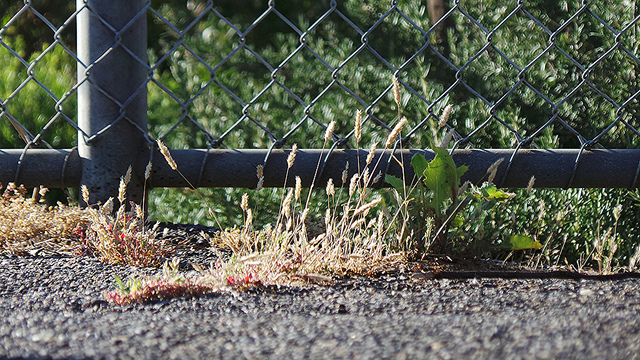The use of glyphosate weedkiller on Auckland parks and footpaths is in the spotlight amidst claims local councils’ spraying programmes are putting the public at risk.
This week, the Green Party issued a media release calling for the Environmental Protection Authority to review the use of glyphosate.
“Our survey of councils shows thousands of litres of glyphosate are used on berms, playgrounds and parks every year, putting people at risk from a probable carcinogen,” said Green Party pesticides spokesperson Steffan Browning.
International Agency for Research on Cancer (IARC) in March 2015 classified glyphosate as a probable human carcinogen. However The Ministry of Primary Industries’ page on glyphosate notes that the IARC classification concerns “whether glyphosate exposure could lead to cancer under any circumstances, whether those circumstances were realistic or not.”
The Science Media Centre contacted New Zealand experts to get more context on the potential risk posed by glyphosate herbicides.
Dr Kerry Harrington, Senior Lecturer in Weed Science, Institute of Agriculture and Environment, Massey University, comments:
“The International Agency for Research on Cancer has decided to group glyphosate within their “probably carcinogenic to humans” classification. It is important to realise this doesn’t mean it does cause cancer, only that only some circumstances, they think it might cause cancer.
“This is the same level of warning as burning wood in the fireplace at home, upsetting circadian rhythms by doing shift work, or being a hairdresser. It is not a high level of risk. Should we ban all shift-work or stop people burning wood in their fireplaces?
“Herbicides are applied carefully. Herbicides are not permitted to drift during application and are usually applied in parks and playgrounds when few people are around, and with signage showing spraying is occurring. The level of concern over use of glyphosate being stirred up in Auckland currently is simply not justified.
“People need to realise that many activities are risky. Using mowers and line trimmers to control vegetation in parks can be risky, if stones are being flicked around. Allowing children to play in the sun is risky, or near water, or on lawns with flowers which might attract bees which cause stings and in some cases anaphylactic reactions.
“Driving to the park through Auckland traffic is probably the riskiest activity many people will face each day. Exposure to a herbicide used for controlling weeds in these parks involves much less risk.
“Many of the points listed by Mr Browning in his press release are open to debate. For example, there is very little movement of glyphosate into waterways as it is tightly bound to soil soon after application. But it will require a literature review to refute all of his statements.”
Prof Ian Shaw, Professor of Toxicology, University of Canterbury, comments:
“Last year the IARC decided that glyphosate is likely to be a human carcinogen based on recently published experimental evidence. This is important because it points a worrying finger at a herbicide that was previously thought to be amongst the safest pesticides we have.
“However, the IARC gave no indication of the dose that might cause cancer and so it is difficult to assess the risk to users. It is likely that the IARC will issue further statements as they assess the data further.
“The finding that glyphosate is a carcinogen in laboratory studies and that this strongly suggests that it will be a human carcinogen means that we should reassess the way we use it. It is clear from the scientific paper that IARC used to make their decision that the cancer risk is low.
“Therefore, at this stage we should make sure that people who are exposed to the greatest amounts of glyphosate take special precautions to reduce their exposure, and that other users are aware of the problem and also take steps to minimise their exposure.
“The highest risk group includes people whose jobs involve spraying glyphosate (e.g. farm workers, council workers) – they should wear appropriate protective clothing. Others, like you or I, who might occasionally spray our drives to kill weeds are at very low risk, but might choose not to accept the risk and use alternative means (e.g. manual weeding).
“Finally, people (particularly children) who are exposed to glyphosate because they (for example) sit on paths that have recently been sprayed are at very low risk. Perhaps councils should label recently sprayed areas as a means of further reducing the risk.
“These are short-term interventions. In the long-term, we should look at means of reducing glyphosate use – there is no doubt in my mind that we are over dependent on it because it is very convenient and, until now, was considered safe.
“On the positive side, glyphosate degrades quickly in the environment and so its carcinogenicity is unlikely to persist in the environment.
“In addition to glyphosate’s carcinogenicity, it has recently been shown (in a single study) to be an endocrine disruptor (i.e. it interferes with the action of hormones; in glyphosate’s case the female hormone estradiol). This is a surprising result, but means that there might be long term environmental implications because of the large amounts used in agriculture. And, of course the risk to humans might not only relate to cancer, but also hormone related issues.
“All of these changes to our understanding of the toxicity of glyphosate underline the need to review its use. This does not mean that we should ban glyphosate outright, but that we should look at ways of significantly reducing its use as a means of reducing human exposure.”
